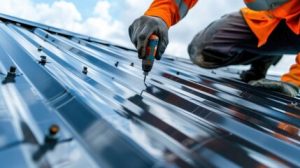Whether you live in a moss-prone climate or near the coast, metal roofs offer homeowners a long-lasting solution that increases home value. The key to getting the best life out of your metal roof is using quality substrates and coatings.

As a contractor, installer, distributor or architect, knowing the pros and cons of each metal roofing option helps you guide your customers towards the right product for their specific situation. Contact Metal Roofing Erie PA for professional help.
The term metal roofing evokes utilitarian impressions of tool sheds with rust-streaked galvanized roofs, rustic barns topped by weathered tin, and military-grade Quonset huts clad in corrugated steel. But the benefits of these durable structures go well beyond their aesthetics, with architects, builders, and contractors recognizing the durability of metal roofs as a wise return on investment for their clients’ commercial or residential properties.
Metal roofs offer a long lifespan far surpassing traditional asphalt shingles, with the exception of copper and zinc that are more expensive but also exhibit exceptional longevity. Depending on the specific alloy and coating used, a metal roof can endure harsh conditions like high humidity, salt air, or intense sunlight. Moreover, some metal roofs have flame-retardant properties that enhance safety in fire-prone areas or situations.
Exceptional wind resistance and hail resistance are additional advantages of metal roofs. The unique wavy design of metal roof panels increases strength and rigidity, which can withstand gusts of up to 140 miles per hour, far exceeding the wind resistance rating of traditional asphalt shingles. As such, a metal roof can help property owners avoid structural damage during severe storms and may even qualify them for homeowner’s insurance discounts.
Additionally, a metal roof’s reflective surface and insulation can help reduce energy costs by lowering surface temperatures, which can further lower HVAC use and energy bills. This increased efficiency can result in significant savings in the long run and can make a metal roof an eco-friendly alternative to other types of roofing.
Durability can also be augmented by regular maintenance, which typically includes inspections for loose or deteriorating screws, as well as keeping the roof free of debris and ensuring that drainage systems are functioning properly. These maintenance tasks can help prevent small issues from becoming larger problems and extend the life of a metal roof past its expected 50-year lifespan.
Aesthetics
Metal roofing offers a wide variety of styles and finishes that can easily integrate with different architectural styles to enhance the visual appeal of buildings. The versatility of these roofs makes them ideal for residential and commercial properties. From corrugated and standing seam panels to metal shingles, these roofs are a great choice for homeowners who want to accentuate the aesthetic of their homes while enjoying durability and energy efficiency benefits.
Modern architectural designs can effortlessly incorporate metal roofs, thanks to their clean lines and neutral or bold finishes. Alternatively, the rustic farmhouse style that is making a comeback can also benefit from this roofing option. In particular, a white or classic gray metal roof will highlight the farmhouse’s natural design elements while remaining stylish and contemporary. Ranch-style homes can likewise benefit from this type of roof due to their sprawling layouts. With the right color scheme, these types of homes can accentuate each section of the building with a distinct look through the use of varying panel sizes and textures.
The various color options that are available for metal roofs provide an array of creative possibilities that can suit the specific needs and preferences of any homeowner. From classic shades like black and gray to bright hues such as rust red, these colors can help create an eye-catching contrast that complements the home’s exterior. Moreover, many of these color options are designed to reflect sunlight and reduce energy consumption, providing the ultimate combination of beauty and sustainability.
Aside from color, the texture of a metal roof can add character and depth to any property. Unlike traditional materials, metal can be customized to emulate the appearance of wood shakes or tile for homeowners who prefer the look of these classic architecture designs. Moreover, textured metal roofs are often preferred for their ability to add visual interest to flat-roofing areas such as garages and patios.
The sturdiness and attractiveness of a metal roof can be further enhanced through the use of coatings and stains that will protect it against the elements. In addition, these coatings can offer a range of additional aesthetic benefits that will further boost the curb appeal of any home.
Energy Efficiency
Many homeowners avoid metal roofing because they believe it will absorb solar heat and increase air conditioning usage, raising energy bills. However, a well-designed metal roof will actually save homeowners money on their energy bills thanks to its reflective properties and energy efficiency.
In fact, one of the top benefits that make metal roofing a popular choice for residential homes is its ability to reduce cooling costs by up to 25%. This is because a metal roof’s surface reflects sunlight and heat, significantly decreasing the need for air conditioning during summer.
A metal roof’s innate energy-efficiency is largely due to its unique atomic structure. This lattice-like structure allows electrons to move freely within the material, making metals highly emissive and able to easily transfer thermal energy from one area of the roof to another. This high level of emissiveness, coupled with the light colors and reflective coatings available for steel roofing, means that when your roof is heated by the sun it will quickly emit the heat back into the atmosphere.
Cool roof pigments and installation methods that promote above-sheathing ventilation are key to maximizing your metal roof’s energy efficiency. However, even dark-colored roofs can achieve impressive levels of emissivity and reflectivity with the use of cool roof paints, and by choosing a lighter color of metal roofing.
Another advantage of a metal roof is that it requires minimal maintenance, saving you money in both the short and long term. The corrosion-resistant coating and tight seams mean that you won’t have to re-seal or re-paint your roof as frequently as other roofing materials.
Energy-efficient metal roofs are also a sustainable choice because they are made from recycled materials and can be fully recycled at the end of their lifespan. This can be especially beneficial for homeowners and builders looking to earn LEED certifications for their construction projects.
In addition, the lightweight design of a metal roof can help to save on shipping and installation costs. In addition, a metal roof will expand and contract as temperatures change, so it is important to account for this movement when installing. Failure to do so can result in damage and leaks. This can be avoided by using a durable underlayment that is compatible with the type of metal roofing you are installing, and by driving screws with proper torque to avoid buckling or warping.
Maintenance
Although metal roofs are long-lasting, they’re not completely maintenance-free. In fact, routine care is the best way to identify minor problems and keep them from escalating into costly repairs.
A metal roof should be inspected at least twice a year, ideally in the fall and spring. This prevents debris accumulation and ensures the surface of the roof is free from dents, scratches, and rust. Additionally, a professional can check that panels and seams are tight, undamaged, and not leaking.
In addition to regular surface-level inspections, you should regularly clean your gutters and downspouts to ensure proper drainage. This also helps prevent debris from clogging the gutter system, which can lead to water backing up on the roof and potentially damaging underlayment and insulation.
Since metal roofs shed water easily, it’s important to keep them clear of any debris that could cause damage or impair flow. This includes leaves, twigs, dirt, and other debris. It’s also a good idea to clean out any debris that could get stuck in valleys on the roof. Additionally, it’s essential to inspect and clean roof penetrations such as air vents, chimneys, skylights, and solar panels. These can often have unique flashing materials that require special attention to ensure they’re in good condition and aren’t exposing the underlying metal to degradation and leaks.
Because of the thermal expansion and contraction of metal roofing systems, it’s a good idea to periodically check that the fasteners used to hold panels in place are tight. Over time, temperature changes can cause them to loosen slightly. Regularly checking and re-tightening them keeps them in good shape, protecting the integrity of the roof and preventing major problems.
A properly maintained metal roof is durable, attractive, and energy efficient. It can also increase the resale value of your home, making it more attractive to potential buyers. If you have any questions about maintaining your metal roof, or would like to schedule an annual inspection with a professional, please contact us. Our experienced roofers are happy to help!
